Este es el reporte de mi primera semana como participante del proyecto comunitario de investigación científica en Hive organizado por @lemouth. La idea de este proyecto es, en palabras de @lemouth: “to simulate signals and backgrounds of the Standard Model, and design a collider analysis with a good signal-background separation power”. No estoy muy seguro de saber lo que eso significa, ya que no soy físico ni científico. Mis conocimientos sobre el tema vienen de haber leído algunos libros de divulgación científica. Así que voy a tratar, desde mi lugar no experto, de colaborar con el proyecto y de aprender lo más posible durante estas semanas.
This is the report of my first week as a participant of the community science research project at Hive organized by @lemouth. The idea of this project is, in the words of @lemouth: "to simulate signals and backgrounds of the Standard Model, and design a collider analysis with a good signal-background separation power". I'm not quite sure I know what that means, since I'm not a physicist or scientist. My knowledge on the subject comes from having read some popular science books. So I will try, from my non-expert place, to collaborate with the project and learn as much as possible during these weeks.
Primer intento: una vieja computadora con Linux
First attempt: an old computer running Linux
La tarea de esta semana consistía en instalar el software que se va a usar en el proyecto: MG5aMC. Este software corre en Linux. A lo largo de mi vida, siempre que he podido he usado Linux como sistema operativo. Sin embargo, hoy el trabajo me obliga a tener instalado Windows, porque tengo que usar ciertos programas que solo corren en este sistema operativo. Además de mi computadora principal, tengo una computadora vieja, de unos 10 años de antigüedad, a la que le instalé hace un tiempo la distribución Manjaro. Mi primera opción para realizar el proyecto, entonces, fue probar si esta computadora podía correr el software.
Descargué el software MG5aMC y seguí los pasos para la instalación. En principio no hubo problemas, pero una vez instalado el software, al correr el tutorial, me di cuenta de que necesitaba fortran. Cuando quise instalar fortran, la computadora empezó a tirar una serie de errores que me llevarían mucho tiempo solucionar. De todos modos, era una computadora que casi no usaba, así que puedo instalar el sistema operativo de cero otra vez.
This week's task was to install the software to be used in the project: MG5aMC. This software runs on Linux. Throughout my life, I have always used Linux as my operating system whenever possible. However, today my work forces me to have Windows installed, because I have to use certain programs that only run on this operating system. In addition to my main computer, I have an old computer, about 10 years old, to which I installed some time ago the Manjaro distribution. My first choice for the project, then, was to test if this computer could run the software.
I downloaded the MG5aMC software and followed the installation steps. At first there were no problems, but once the software was installed, when running the tutorial, I realized that I needed fortran. When I wanted to install fortran, the computer started throwing a series of errors that would take me a long time to fix. Anyway, it was a computer I hardly used, so I can install the operating system from scratch again.
Segundo intento: una máquina virtual en Windows
Second attempt: a virtual machine on Windows
La segunda opción, entonces, fue crear una máquina virtual en mi computadora con Windows. Para ello, descargué e instalé VirtualBox primero y y Ubuntu después.
The second option, then, was to create a virtual machine on my Windows computer. To do this, I downloaded and installed VirtualBox first and Ubuntu later:
Luego, creé una máquina virtual nueva, elegí el nombre y el tipo (Linux, Ubuntu). Seleccioné la cantidad de memoria y un disco rígido de 10 GB VDI de tamaño fijo. El proceso de creación de la máquina virtual toma un buen rato.
Then, I created a new virtual machine, chose the name and type (Linux, Ubuntu). I selected the amount of memory and a fixed size 10 GB VDI hard disk. The process of creating the virtual machine takes quite a while.

El siguiente pasó fue instalar Ubuntu en la máquina virtual. Para ello hay que ir a la configuración de la máquina virtual y, en la parte de almacenamiento, seleccionar el que dice “Vacío” dentro de “Controlador: IDE” y elegir la imagen .iso de Ubuntu.
The next step was to install Ubuntu in the virtual machine. To do this you have to go to the virtual machine configuration and, in the storage part, select the one that says "Empty" under "Controller: IDE" and choose the Ubuntu .iso image.
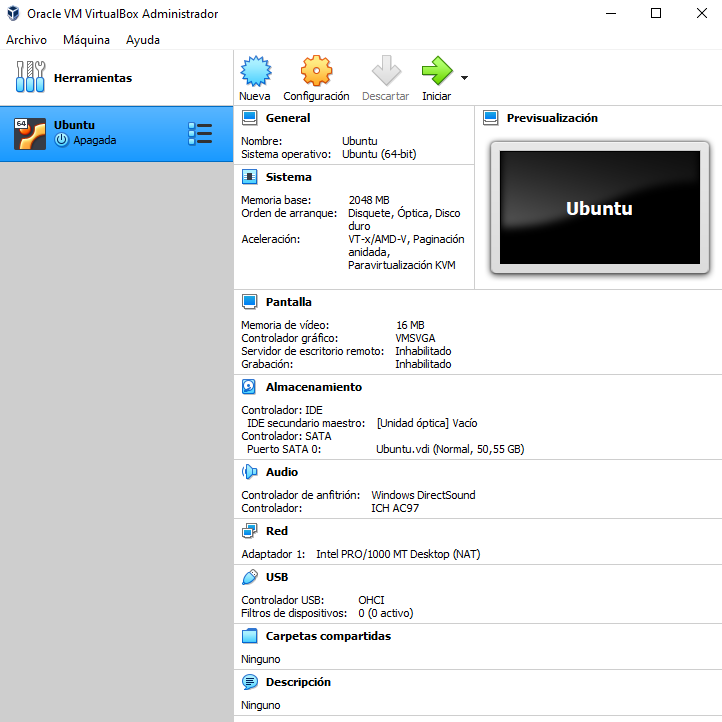
Luego, inicié la máquina virtual y comencé la instalación del sistema operativo. En mi caso, elegí la opción de instalación mínima porque no voy a necesitar la mayoría de las cosas que vienen en la instalación completa.
Then, I started the virtual machine and began the installation of the operating system. In my case, I chose the minimal installation option because I won't need most of the things that come in the full installation.
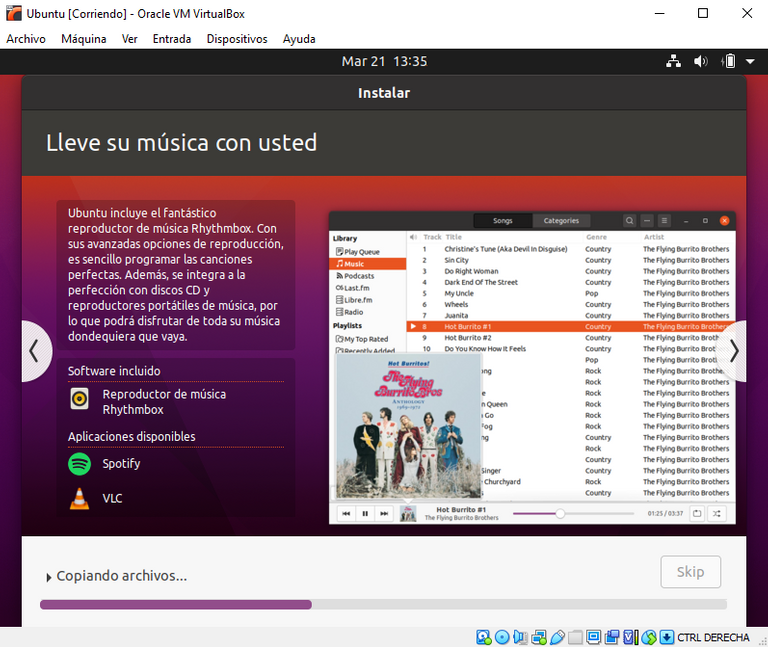
Y en un rato Ubuntu ya estaba instalado. ¡Qué lejos quedaron los tiempos en que instalar Linux era complicado!
And in no time Ubuntu was already installed, long gone are the days when installing Linux was complicated!
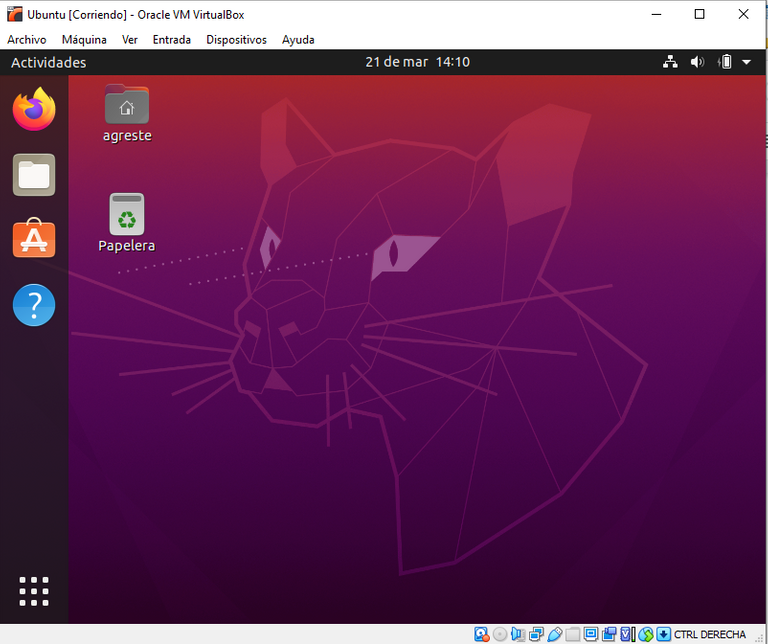
Llegó entonces el momento de comenzar con la tarea en sí, es decir, de instalar el software MG5aMC. Lo pasé a la máquina virtual (porque ya lo había descargado) y abrí la terminal.
Then it was time to start with the task itself, that is, to install the MG5aMC software. I moved it to the virtual machine (because I had already downloaded it) and opened the terminal.
El primer paso fue descomprimir el archivo.
The first step was to unpack the file.

Luego, abrí el programa.
Then, I opened the program.
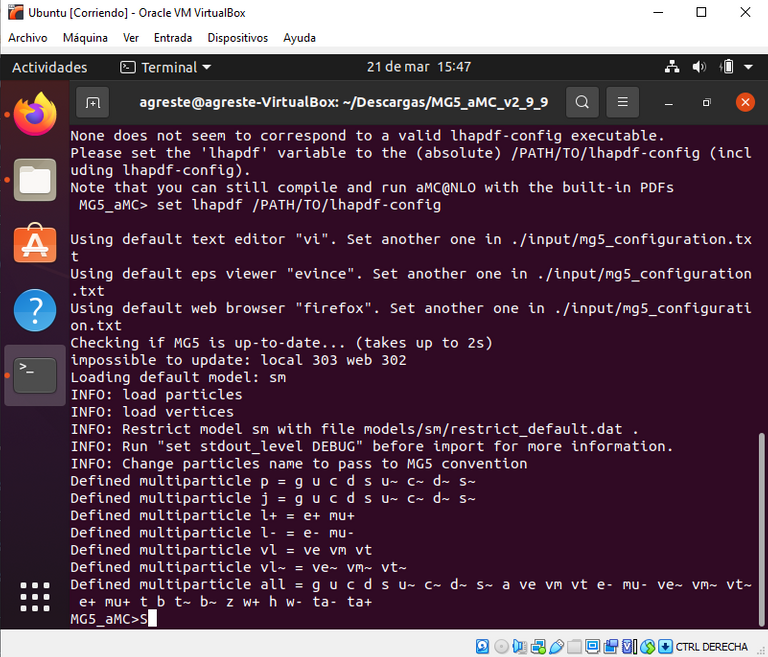
En este momento, me acordé de que iba a necesitar fortran. Así que instalé el paquete gfortran.
At this point, I remembered that I was going to need fortran. So I installed the gfortran package.
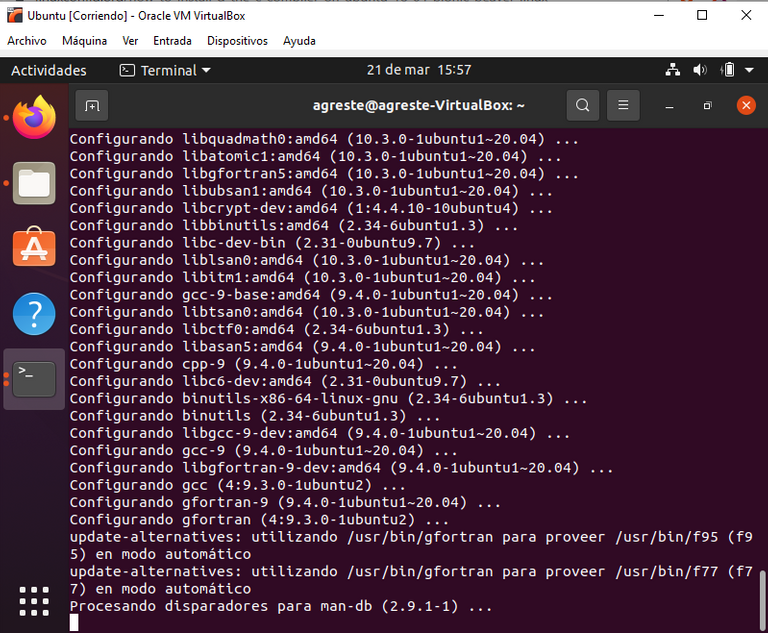
En el tutorial, también decía que era necesario g+ +, así que lo instalé también.
In the tutorial, it also said that g++ was needed, so I installed that as well.

Luego, instalé el paquete adicional lhapdf6, pero recibí el siguiente error:
Then, I installed the additional package lhapdf6, but I got the following error:
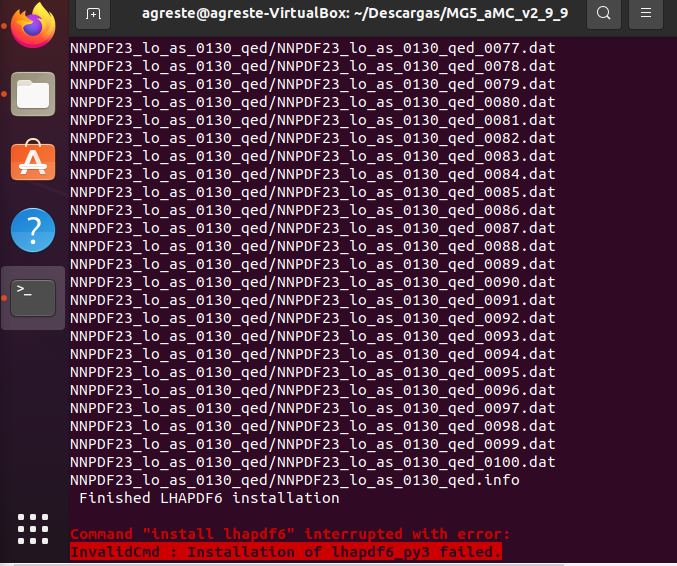
Busqué en internet y si bien no encontré el mismo error, encontré alguno similar en un foro. Allí recomendaban instalar primero el paquete boost. Lo hice pero el error persistía. Instalé entonces build-essential y ahí sí pude instalar lhapdf6 sin problemas.
I searched the internet and while I didn't find the same error, I found a similar one on a forum. There they recommended installing the boost package first. I did it but the error persisted. Then I installed build-essential and I was able to install lhapdf6 without problems.
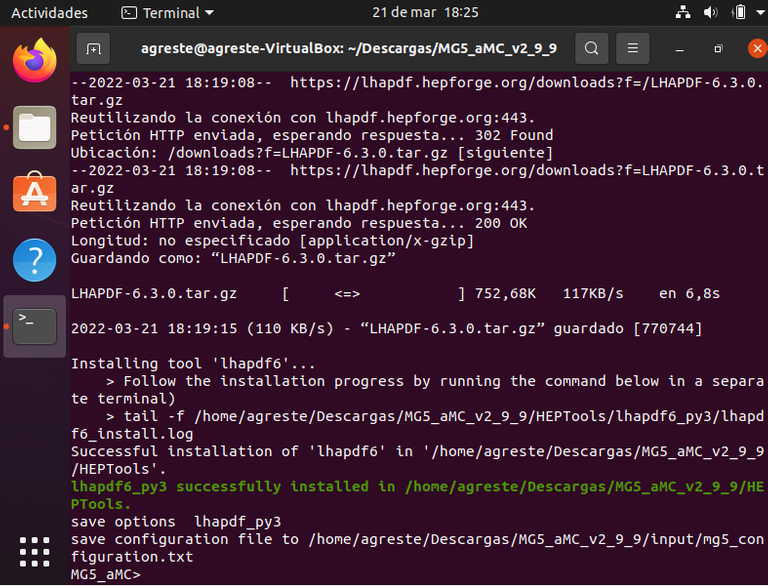
Seguí entonces con phytia8.
I then continued with phytia8.
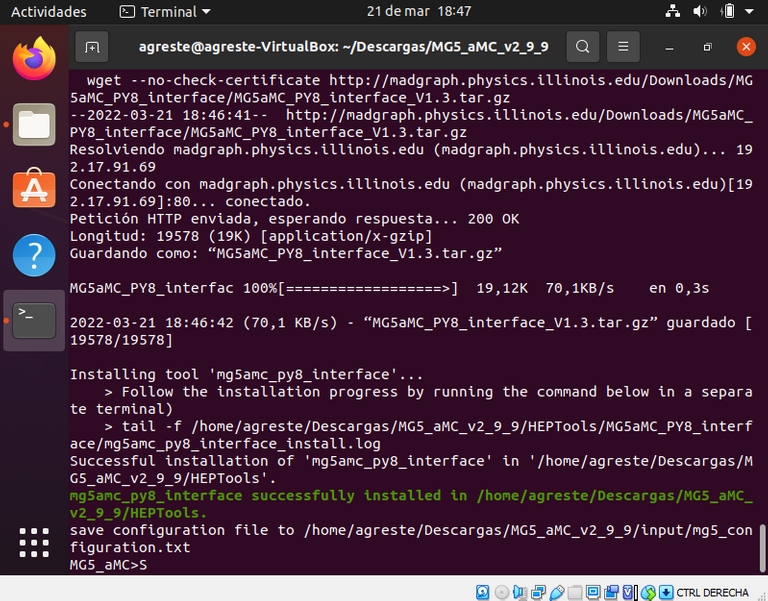
Finalmente, corrí el tutorial de MG5aMC.
Finally, I ran the MG5aMC tutorial.
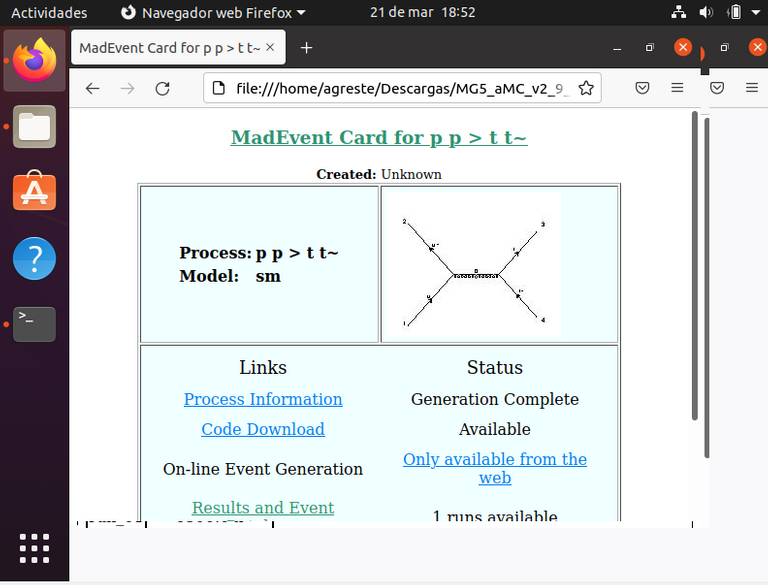
Bueno, eso fue todo por esta semana. ¡Todo listo para la siguiente tarea!
Well, that's it for this week, all set for the next task!
Original en español. Traducido al inglés con Deepl.
Todas las imágenes son capturas de pantallas del proceso hechas por mí.
Original in Spanish. Translated to English with Deepl.
All images are screenshots of the process made by me.
Thanks a lot for taking part to this project. Concerning the physics prerequisites, don’t worry. There is simply none of them. The idea is to move on slowly, together, so that I could explain everything in due time. At the end of the adventure, I am sure that you will understand (almost) everything. Somehow, we can see this project as an option to learn by practice.
I am happy to read that you managed to solve the Fortran issue. I assume the problems were all related to the old operating system you had on our Linux machine. Also, I apologise for not having indicated this in the initial post. I simply forgot, but this was pointed out by several participants, in particular @eniolw and @servelle who went into this quite early. The post had been updated with this respect at the end of last week.
Concerning the virtual machine, a 10 GB fixed disk space may be too small. The problem is that we will need to generate huge intermediate temporary files of several GBs. Those files won’t be stored on disk forever, but we need to store them at least during the time we post-process them. I will explain that in details in due time.
Finally, I have updated my post with information on boost and build-essential. Thanks for pointing this out. This is something I knew, but forgot ;)
Thanks a gain for this very nice and useful report!
Cheers!
Thanks a lot! Yes, my goals are to collaborate and learn. How much do you think would be a good size for the disc? I have space, it wouldn't be a problem, I only put 10 because I thought it would be enough. Cheers!
I think that with the virtual box, you can set the disk space to be dynamical. That should be the best option, in my opinion. Otherwise, 50 GB is comfortable.
I will also investigate on my side about how to get some online shared space, when this will be neede. In this way, our individual simulations could be put in common and shared.
Perfect, I take it to 50 gb and enlarge it even more if necessary. I'm not sure if it can be changed from fixed to dynamic once created, but I'll look into it. thanks!
You are welcome. The post of this week will appear slightly later (hopefully tomorrow, most probably on Friday). I have important university issues to deal with, and they delay a bit everything.
Ok, no problem, I'm having a busy week too!
I had the similar problems, went directly to install the software and then noticed that, being a new machine most of the useful packages that we usually have installed like the ones in build-essentials were not installed.
Reading your post yesterday when I was installing myself would have saved me some time but hey, this is why we document these things so the next ones will not have this problem.
Very good explanation and it is good to see the spanish version too!
Thank you very much! Yes, I am used to having the same distro for many years, so I had forgotten that I had to install those packages. Totally, that's the point of documenting, I would have saved myself some time with fortran too if I had read other contributor's reports first. Cheers!
Thanks for sharing!
!1UP
thanks!!
You have received a 1UP from @ivarbjorn!
@stem-curator, @vyb-curator, @pob-curator, @neoxag-curatorAnd they will bring !PIZZA 🍕
Learn more about our delegation service to earn daily rewards. Join the family on Discord.
PIZZA Holders sent $PIZZA tips in this post's comments:
@curation-cartel(19/20) tipped @agreste (x1)
Please vote for pizza.witness!
Thanks for your contribution to the STEMsocial community. Feel free to join us on discord to get to know the rest of us!
Please consider delegating to the @stemsocial account (85% of the curation rewards are returned).
You may also include @stemsocial as a beneficiary of the rewards of this post to get a stronger support.
Yay! 🤗
Your content has been boosted with Ecency Points, by @agreste.
Use Ecency daily to boost your growth on platform!
Support Ecency
Vote for new Proposal
Delegate HP and earn more